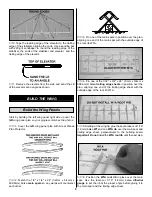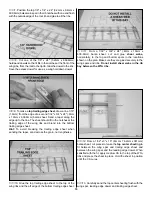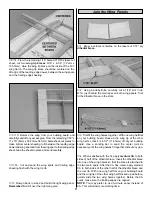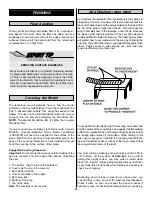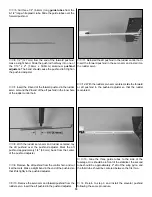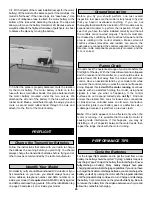
there may be others like yourself who could be flying
nearby. If both of your models happen to be on the same
frequency, interference will likely cause one or both of the
models to crash. An acceptable minimum distance between
flying models is five miles, so keep this in mind when
searching for a flying site.
In addition to obstacles, it is important to be aware of people
who may wander into the area once you begin flying. At
AMA club flying sites it is a severe rule infraction to fly over
others, and this is a good rule to follow if flying elsewhere.
Please be aware, R/C models tend to attract interested
onlookers. Onlookers pose two main problems. First is the
danger of actually crashing your model into a person,
causing injury. Second is the distraction of those who ask
you questions while you are trying to concentrate on flying.
To minimize or avoid this problem, have an assistant
standing by who can spot people who wander into your
flying site (so you can avoid flying over them) and who can
perform “crowd control” if people start to gather.
IMPORTANT:
If you are an inexperienced modeler we
strongly urge you to seek the assistance of a competent,
experienced R/C pilot to check your model for airworthiness
AND to teach you how to fly. No matter how stable or
“forgiving” the BLT is, attempting to learn to fly on your own
is dangerous and may result in destruction of your model or
even injury to yourself and others. Therefore, find an
instructor and fly only under his or her guidance and
supervision until you have acquired the skills necessary for
safe and fully controlled operation of your model.
We recommend flying the BLT when the wind is no greater
than five miles per hour. Less experienced flyers should fly
the BLT only in calm (less than one mile per hour)
conditions. Frequently, winds are calm in the early morning
and early evening. Often these are the most enjoyable
times to fly anyway!
Until you have the BLT properly trimmed for level flight, we
recommend having an assistant hand-launch the model
instead of taking off from the ground.
Turn on the transmitter and plug the battery into the
speed control.
IMPORTANT:
Confirm that the transmitter operates the
controls by moving the sticks and watching the surfaces
respond. Occasionally, electric models have been launched
with the transmitter turned off or the battery disconnected
from the speed control!
When ready to launch, the assistant should hold the bottom
of the fuselage behind the landing gear, then raise the
model high above his head and point it
into the wind
. With
the pilot
(that would be you!)
standing behind the plane, fully
advance the throttle to start the motor. As soon as the motor
is at full power, the hand launcher should gently toss the
plane into the air at a
level
or
slightly
nose-up attitude. Be
certain the model is being launched
into
the wind and be
immediately ready to make corrections to keep the airplane
flying straight, level and into the wind.
When the model has gained adequate flying speed under
its own power,
gently
pull the elevator stick back until the
airplane starts a gradual climb. Many beginners tend to pull
too hard causing the model to stall, so be gentle on the
elevator and don’t panic. If you do pull too hard and you
notice the model losing speed, release the elevator stick
and allow the model to regain airspeed.
Continue a
gradual
climb and establish a gentle turn (away
from yourself) until the airplane reaches an altitude of 75 to
100 feet.
The main purpose of the first few flights is to learn how the
model behaves and to adjust the trims for level flight. After
the model has climbed to a safe altitude reduce the throttle
slightly to slow the model, yet maintain altitude. The BLT
should fly well and maintain adequate airspeed at about half
to 3/4 throttle.
Adjust the elevator trim so the model flies level at the
throttle setting you are using. Adjust the rudder trim to level
the wings. It may take a few passes to get the trims
adjusted, but this should be your first priority once at a
comfortable altitude. Continue to fly around, executing turns
and making mental notes (or having your assistant take
notes for you) of what additional adjustments or C.G.
changes may be required to fine tune the model so it flies
the way you like.
If the BLT reaches a high enough altitude, you may
periodically cut off the motor power and glide. This may
extend the flight time by several minutes, especially if you
fly into a rising air current.
Flight
Takeoff
FLYING
22
Summary of Contents for BLT
Page 24: ...TWO VIEW...


